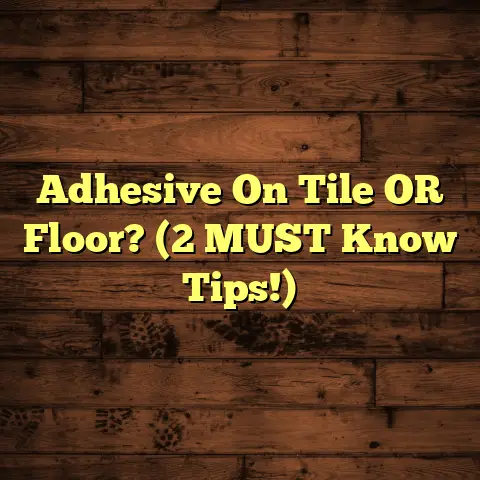Long-Term Hardwood Care? (7 Costly Errors!)
Have you ever considered how a single mistake in caring for your hardwood floors could cost you thousands in repairs and replacements?
It’s easy to take it for granted, but trust me, I’ve seen enough flooring nightmares to know that a little preventative care goes a long way.
As a flooring contractor with years of experience, I’ve seen it all, from minor scratches to full-blown floor replacements caused by simple, avoidable mistakes.
Let’s dive into the world of hardwood care and uncover the seven most costly errors that homeowners make.
Section 1: Understanding Hardwood Flooring
Let’s start with the basics. What exactly is hardwood flooring?
You’ve got two main types: solid hardwood and engineered wood.
Solid hardwood is exactly what it sounds like: planks milled from a single piece of wood. Think oak, maple, cherry – the classic choices.
Engineered wood, on the other hand, is made of multiple layers of wood veneer glued together, with a hardwood layer on top.
Both have their pros and cons, but both are a fantastic investment for your home.
Why? Well, hardwood flooring is incredibly durable, looks amazing, and can actually increase your home’s value.
According to the National Association of Realtors, hardwood flooring is consistently ranked as one of the most desirable features for homebuyers. https://www.nar.realtor/
But here’s the catch: that durability and value depend on proper long-term care.
Think of your hardwood floors like a classic car. You wouldn’t just drive it and forget about it, right?
You’d need to keep it clean, get regular maintenance, and protect it from the elements.
The same goes for your floors. Long-term care is all about preserving the beauty and functionality of your hardwood for years to come.
It’s about preventing problems before they start and addressing minor issues before they turn into major headaches.
Section 2: The Costly Error #1: Neglecting Regular Maintenance
Okay, let’s get down to brass tacks. The number one mistake I see homeowners make is simply neglecting regular maintenance.
I get it, life is busy. But trust me, a little bit of routine care can save you a lot of money in the long run.
What does regular maintenance look like?
Think of it as a three-step process: cleaning, dusting, and resealing.
Cleaning: This means regular sweeping or vacuuming to remove dirt and debris that can scratch the surface of your floors.
Dusting: Microfiber mops are your best friend here. They pick up dust and allergens without damaging the finish.
Resealing: Depending on the type of finish you have, you may need to reseal your floors every few years to protect them from wear and tear.
Now, what happens if you neglect this routine? Well, let me tell you, it’s not pretty.
I’ve seen floors that have been completely ruined by ground-in dirt and grime. Scratches, discoloration, and even structural damage can occur over time.
According to a study by the National Wood Flooring Association (NWFA), neglecting regular maintenance can reduce the lifespan of your hardwood floors by as much as 50%. https://www.nwfa.org/
That’s a huge difference!
And it’s not just about aesthetics. Neglecting minor issues like scratches and discoloration can lead to more serious problems down the road.
For example, a small scratch can allow moisture to penetrate the wood, leading to warping and rot.
What starts as a tiny imperfection can quickly turn into a major repair project.
I remember one client who ignored a small water stain on their oak floor for months.
By the time they called me, the stain had spread and the wood underneath was starting to rot.
The cost to repair the damage was significantly higher than it would have been if they had addressed the issue promptly.
Section 3: The Costly Error #2: Using the Wrong Cleaning Products
Alright, so you’re committed to regular cleaning. That’s great!
But here’s another common mistake I see: using the wrong cleaning products.
I can’t tell you how many times I’ve walked into a home and seen floors that have been damaged by harsh chemicals.
The problem is, many common household cleaning products contain ingredients that can strip the finish off your hardwood floors, leaving them dull and unprotected.
Vinegar, ammonia-based cleaners, and even some all-purpose cleaners can be particularly damaging.
These products can break down the finish, causing discoloration, scratches, and even warping.
So, what should you use instead? The best option is to use cleaning solutions specifically designed for hardwood floors.
Many manufacturers recommend their own cleaning products, and it’s always a good idea to follow their recommendations.
These products are formulated to clean your floors without damaging the finish.
You can also use a simple solution of water and a mild soap, but be sure to use a minimal amount of water and dry the floors thoroughly afterwards.
Remember, excess water can seep into the wood and cause damage.
I always tell my clients to avoid using steam cleaners on hardwood floors.
While steam cleaning can be effective for other types of flooring, the high heat and moisture can damage the finish and cause warping.
I had one client who used a steam cleaner on their brand new hardwood floors, thinking it would be a quick and easy way to clean them.
Unfortunately, the steam caused the finish to bubble and peel, and the floors had to be completely refinished.
That was an expensive mistake!
The long-term effects of improper cleaning can be significant. Over time, the finish on your floors will become dull and worn, making them more susceptible to scratches and damage.
Eventually, you may need to refinish your floors, which can be a costly and time-consuming process.
Section 4: The Costly Error #3: Ignoring Humidity and Temperature Control
Okay, let’s talk about something that many homeowners don’t think about: humidity and temperature control.
Did you know that fluctuations in humidity and temperature can have a major impact on your hardwood floors?
Wood is a natural material, and it expands and contracts in response to changes in humidity and temperature.
When the air is humid, the wood absorbs moisture and expands. When the air is dry, the wood loses moisture and contracts.
These fluctuations can cause your hardwood floors to warp, crack, and develop gaps.
In extreme cases, the floors can even buckle or lift off the subfloor.
The ideal conditions for maintaining hardwood flooring are a relative humidity of 35-55% and a temperature of 60-80°F.
You can use a hygrometer to monitor the humidity levels in your home.
If the humidity is too high, you can use a dehumidifier to remove excess moisture from the air.
If the humidity is too low, you can use a humidifier to add moisture to the air.
It’s also important to maintain a consistent temperature in your home.
Avoid drastic temperature changes, as these can put stress on your hardwood floors.
I remember one client who had a beautiful hardwood floor in their sunroom.
Unfortunately, the sunroom was not properly insulated, and the temperature fluctuated wildly throughout the day.
In the summer, the room would get extremely hot, and in the winter, it would get very cold.
Over time, the extreme temperature changes caused the hardwood floor to warp and crack.
The client ended up having to replace the entire floor, which was a very expensive project.
Proper climate control is especially important in certain regions of the country.
In areas with high humidity, such as the Southeast, it’s essential to use a dehumidifier to prevent moisture damage.
In areas with dry climates, such as the Southwest, it’s important to use a humidifier to prevent the wood from drying out and cracking.
Section 5: The Costly Error #4: Failing to Protect Against Furniture Damage
Alright, let’s talk about furniture. We all have it, and we all need to be mindful of how it impacts our hardwood floors.
Heavy furniture, like sofas, tables, and bookshelves, can put a lot of pressure on your floors.
Over time, this pressure can cause dents, scratches, and even structural damage.
The lack of protective pads is a major culprit here. Without pads, the legs of your furniture can dig into the floor, leaving unsightly marks.
So, what can you do to protect your floors from furniture damage?
The first thing you should do is invest in high-quality furniture pads.
These pads should be placed under the legs of all your furniture, including sofas, chairs, tables, and bookshelves.
Make sure the pads are made of a soft, non-abrasive material, like felt or cork.
Avoid using plastic or rubber pads, as these can actually damage the finish on your floors.
When moving furniture, always lift it instead of dragging it. Dragging furniture can cause deep scratches and gouges in your floors.
If you have to move heavy furniture, consider using furniture sliders.
These sliders are placed under the legs of the furniture, allowing you to easily slide it across the floor without causing damage.
It’s also important to be mindful of furniture placement and weight distribution.
Avoid placing heavy furniture in areas that are prone to moisture, such as near doorways or windows.
Also, try to distribute the weight of your furniture evenly across the floor.
Don’t put all your heavy furniture in one corner of the room, as this can put undue stress on the floor.
I had one client who had a beautiful antique desk that they loved.
Unfortunately, the desk was very heavy, and they didn’t use any protective pads under the legs.
Over time, the weight of the desk caused deep dents in the hardwood floor.
The client ended up having to replace the damaged section of the floor, which was a costly repair.
Section 6: The Costly Error #5: Skipping Professional Inspections
Okay, let’s talk about something that many homeowners overlook: professional inspections.
I know, I know, it sounds like an unnecessary expense. But trust me, periodic professional assessments of your hardwood floors can save you money in the long run.
Think of it like going to the doctor for a checkup. You might feel fine, but a doctor can identify potential problems before they become serious.
The same goes for your hardwood floors. A professional inspector can identify issues that you might not notice, such as moisture damage, insect infestations, or structural problems.
What do professionals look for during an inspection?
They’ll check for signs of moisture damage, such as warping, cupping, or discoloration.
They’ll also look for signs of insect infestations, such as small holes or sawdust.
They’ll inspect the finish on your floors to see if it’s worn or damaged.
And they’ll check the subfloor to make sure it’s level and stable.
Early detection of these issues can save you a lot of money. For example, if you catch a moisture problem early, you can address it before it causes significant damage to your floors.
If you catch an insect infestation early, you can get rid of the pests before they cause extensive damage to the wood.
I recommend having your hardwood floors inspected by a professional at least once every three to five years.
If you live in an area with high humidity or extreme temperatures, you may want to have them inspected more frequently.
I had one client who called me in to inspect their hardwood floors after they noticed a musty smell in their home.
During the inspection, I discovered that there was a hidden water leak under the floor.
The leak had been going on for months, and it had caused significant damage to the subfloor.
If the client had waited any longer, the damage would have been much worse, and the repair costs would have been much higher.
Many homeowners have benefited from professional advice and maintenance.
They’ve been able to avoid costly repairs, extend the lifespan of their floors, and maintain the beauty of their homes.
Section 7: The Costly Error #6: Overlooking the Importance of Refinishing
Alright, let’s talk about refinishing. What is it, and why is it so important for long-term hardwood maintenance?
Refinishing is the process of sanding down the existing finish on your hardwood floors and applying a new coat of finish.
This process removes scratches, dents, and other imperfections, and it restores the beauty and luster of your floors.
But why is it so essential? Well, over time, the finish on your hardwood floors will wear down, leaving them vulnerable to damage.
Scratches, dents, and spills can penetrate the worn finish and damage the wood underneath.
Refinishing your floors every few years will protect them from damage and keep them looking their best.
What are the signs that indicate a floor needs refinishing?
Look for scratches, dents, and other imperfections that are visible on the surface of the floor.
Also, look for areas where the finish is worn or dull.
If your floors look old and tired, it’s probably time to refinish them.
The costs associated with refinishing can vary depending on the size of the area, the type of finish you choose, and the contractor you hire.
However, refinishing is typically much less expensive than replacing your floors.
What are the benefits of refinishing versus the consequences of delaying this necessary step?
Refinishing will restore the beauty of your floors, protect them from damage, and extend their lifespan.
Delaying refinishing can lead to more serious damage, such as warping, cracking, or rot.
Eventually, you may need to replace your floors, which can be a very expensive project.
I had one client who delayed refinishing their hardwood floors for years.
They kept putting it off, thinking it was too expensive and time-consuming.
Unfortunately, the floors became so damaged that they had to be completely replaced.
The cost of replacing the floors was much higher than the cost of refinishing them would have been.
Section 8: The Costly Error #7: DIY Repairs Gone Wrong
Okay, let’s talk about DIY repairs. I’m all for saving money, but when it comes to hardwood floors, DIY repairs can often do more harm than good.
I’ve seen so many common DIY mistakes that homeowners make when attempting to repair their hardwood floors.
They use the wrong tools, they apply the finish incorrectly, or they simply don’t know what they’re doing.
The potential pitfalls of inadequate repairs are numerous. You can damage the finish, create uneven surfaces, or even cause structural damage to the floor.
And the expenses involved in fixing botched jobs can be significant.
You may have to hire a professional to undo your mistakes, and you may even have to replace the damaged section of the floor.
So, how do you know when to call in a professional versus attempting DIY solutions?
If you’re dealing with a minor scratch or dent, you may be able to repair it yourself using a touch-up kit.
However, if you’re dealing with more serious damage, such as warping, cracking, or rot, it’s best to call in a professional.
Also, if you’re not comfortable working with power tools or applying finishes, it’s best to leave the repairs to the pros.
I had one client who tried to repair a water-damaged section of their hardwood floor themselves.
They removed the damaged boards and replaced them with new ones.
However, they didn’t properly seal the new boards, and they didn’t match the finish to the rest of the floor.
The result was a mismatched, uneven repair that looked worse than the original damage.
They ended up having to hire me to redo the entire repair, which cost them even more money than it would have if they had called me in the first place.
Conclusion
So, there you have it: the seven most costly errors in long-term hardwood care.
I know it seems like a lot to remember, but trust me, taking the time to understand and avoid these mistakes will protect your investment in hardwood flooring for years to come.
Remember, making informed decisions about maintenance can save you money, extend the lifespan of your floors, and maintain the beauty of your home.
Now, I want you to take a moment to evaluate your current hardwood care practices.
Are you making any of these mistakes? If so, it’s time to make a change.
Don’t wait until it’s too late. The long-term implications of neglect can be significant.
Take action today to protect your hardwood floors and enjoy their beauty for years to come!




